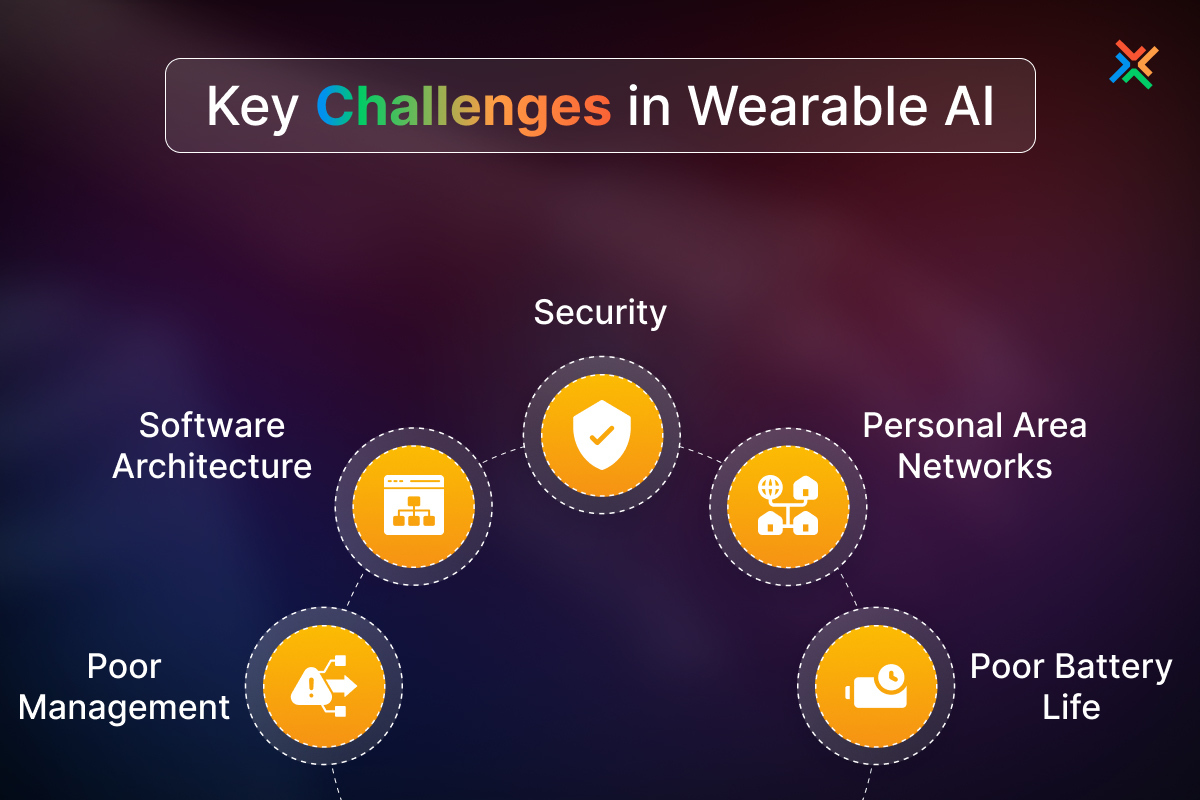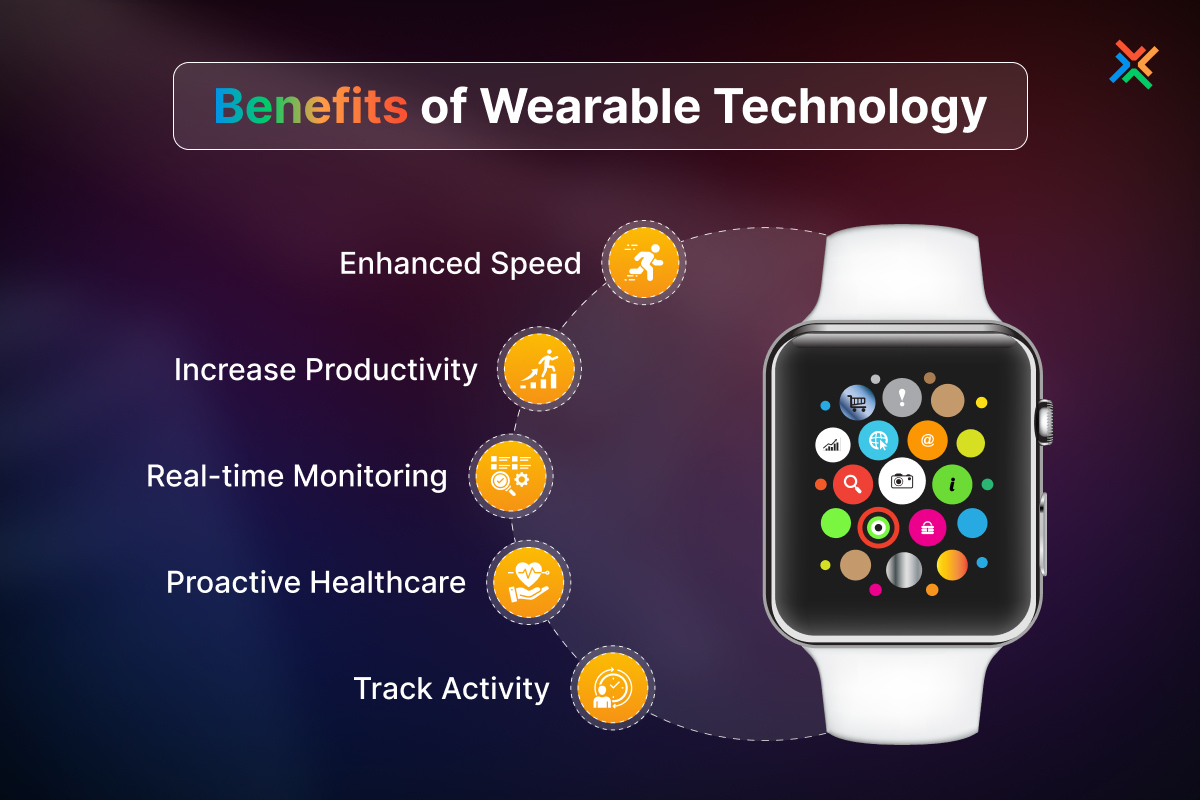The Future of Wearable AI: What Comes After Smartwatches
April 19, 2024

Vivek Adatia

Smartwatches have become a familiar sight on wrists around the world. From fitness tracking to contactless payments, these versatile devices have undeniably transformed how we interact with technology on the go. However, the wearable tech space is set for a significant leap forward. Wearable AI is the next wave of technology poised to transform how we interact with the world around us.
For instance, wearable AI can lead to shirts that tailor their temperature based on your activity level, earbuds that personalize your music based on your mood, or glasses that project information directly onto your field of vision. Wearable AI promises to weave intelligence into the very fabric of our clothes and accessories, creating a seamless and intuitive connection between us and technology.

This exciting new development is fueled by the burgeoning field of AI application development services. These specialized companies are creating intelligent features that will power the next generation of wearables, taking them far beyond simple notification and step counting. As AI and wearable technology converge, exciting possibilities await, fundamentally changing how we utilize these devices to improve our health, fitness, and overall well-being.
What is Wearable AI?
Wearable AI takes the familiar concept of wearable technology and infuses it with the power of artificial intelligence. These intelligent devices are not limited to collecting data; they harness built-in AI algorithms to analyze that data and provide actionable insights. Here's what makes Wearable AI unique.
Data Powerhouse
Wearable AI devices are equipped with a diverse array of sensors, transforming them into data collection powerhouses. These sensors can capture a wide range of information, from basic metrics like heart rate and steps taken to more advanced details like sleep patterns, blood oxygen levels, and even ambient noise levels. This comprehensive data collection provides a rich picture of the user's health, activity, and environment.
Real-Time Intelligence
The true potential of Wearable AI lies in its ability to analyze this collected data in real-time using embedded AI algorithms. This allows the device to identify trends, patterns, and potential issues as they occur. For instance, an AI-powered smartwatch might detect an abnormal heart rhythm during exercise and prompt the user to slow down or seek medical attention. This real-time decision-making capability helps users take immediate action based on their body's feedback.
Personalized Experiences
Wearable AI personalizes the user experience like never before. Unlike generic fitness trackers that offer a one-size-fits-all approach, wearable AI taps into its understanding of your unique data to provide personalized recommendations and support. For instance, a fitness tracker powered by AI can analyze your workout performance and suggest modifications to optimize your training based on your individual strengths and weaknesses. Or, an AI-powered smartwatch can monitor your sleep patterns and recommend personalized sleep hygiene strategies to improve your sleep quality. Wearable AI allows for a truly customized approach to health and wellness.
However, processing this vast amount of data and running complex AI algorithms on a tiny device presents a unique set of technical challenges
Processing Power
Wearable AI devices often rely on a hybrid approach, utilizing a combination of on-device processing and cloud-based AI. For tasks requiring significant processing power, such as complex data analysis or advanced pattern recognition, the data might be transmitted securely to the cloud for analysis by more powerful AI systems. Simpler tasks, like step counting or heart rate monitoring, can be handled directly on the device itself. This hybrid approach helps to balance processing power with battery life.
Sensor Integration
The accuracy and functionality of Wearable AI depend heavily on the efficient integration of various sensors. These sensors act as the eyes and ears of the device, collecting the raw data that the AI algorithms need to function effectively. From accelerometers for tracking movement to bioimpedance sensors for analyzing body composition, a diverse range of sensors work in harmony to provide a comprehensive picture of the user's health and activity. The quality and accuracy of these sensors directly impact the effectiveness of the AI analysis.
Efficient power management
One of the biggest hurdles for Wearable AI is battery life. Running complex algorithms constantly can drain a battery quickly. Therefore, efficient power management techniques are crucial to ensure these devices can function throughout the day without needing frequent recharging. This might involve optimizing the processing power used by the AI algorithms, employing low-power sensor technologies, and implementing features that allow users to manage battery consumption. By addressing these challenges, Wearable AI opens up a new generation of intelligent wearables that can integrate into our daily lives.
Applications of Wearable AI
Wearable AI isn’t just about fancy features. It has the potential to transform how we approach our health, fitness, and even fashion. Here’s a glimpse into some of the exciting applications of Wearable AI across various sectors.

Health & Wellness
Beyond simply monitoring steps, AI-powered wearables are becoming sophisticated health companions. These devices can continuously track a wider range of health metrics, including heart rate, sleep patterns, blood oxygen levels, and even stress levels. The built-in AI analyzes this data, looking for trends and potential abnormalities. For instance, an AI-powered smartwatch might detect an irregular heartbeat or identify sleep disturbances that could indicate underlying health concerns. By prompting users to seek medical attention or recommending lifestyle changes, these devices can play a proactive role in preventative healthcare. However, creating secure and reliable healthcare applications necessitates expertise in AI development services. These specialized services are crucial for ensuring the data collected by wearables is protected and the AI algorithms provide accurate and actionable insights.
Fitness & Performance
The world of fitness is also getting a major AI upgrade. AI-powered fitness trackers and smartwatches are no longer just passive observers. They can analyze your workout data in real-time, assess your performance, and suggest personalized workout routines personalized to your individual needs and goals. Consider a fitness tracker that analyzes your running form and recommends adjustments to improve your efficiency or a smartwatch that monitors your fatigue levels and suggests taking a rest break to optimize your training. These intelligent features are built by AI software development companies, allowing wearables to become personalized coaches that can help you achieve your fitness goals faster and more effectively.
Smart Clothing & Fashion Tech
The future of fashion is getting smarter too. AI-integrated clothing is emerging, equipped with sensors and AI capabilities that can enhance our comfort and well-being. Consider a jacket that automatically adjusts its temperature to keep you comfortable in various environments, or pants that monitor your muscle activity and provide real-time feedback during exercise. These intelligent garments require specialized AI application development services to create algorithms that can interpret sensor data and translate it into meaningful actions. By merging cutting-edge AI with fashion, wearable AI is blurring the lines between technology and style, creating a new wave of smart clothing that can enhance our daily lives in unexpected ways.
Entertainment
Wearable AI is also set to transform our entertainment experiences. Smart glasses with integrated AR/VR capabilities could overlay virtual objects onto the real world, allowing you to interact with games or information in entirely new ways. AI-powered wearables could personalize content recommendations, suggesting music or movies based on your preferences and even your current mood.
Productivity
Wearable AI can also become powerful tools for boosting productivity. Smartwatches can act as intelligent assistants, reminding you of tasks, managing your calendar, or even filtering incoming notifications based on your priorities. Voice commands integrated with AI can allow for hands-free information retrieval, making it easier to access important data on the go.
Challenges and Opportunities
The future of wearable AI looks bright. However, there are some key challenges that need to be considered.
Challenges to Address
- Data Privacy and Security
Wearable AI devices collect a vast amount of personal data. Ensuring the security and privacy of this data is crucial. Robust security measures and clear user control over data collection are crucial to building trust and encouraging user adoption. - Battery Life Limitations
The power demands of running complex AI algorithms on a small device can significantly impact battery life. Advancements in low-power chip design and efficient power management techniques are necessary to ensure wearables can function throughout the day without needing frequent recharging. - User Acceptance and Design Considerations
Wearable AI needs to be comfortable, user-friendly, and aesthetically pleasing to gain widespread adoption. This requires careful design considerations to ensure wearables are seamlessly integrated into daily life without becoming a burden.

Opportunities on the Horizon
Despite these challenges, Wearable AI presents a wealth of exciting possibilities.
- Improved Quality of Life
Wearable AI has the potential to significantly improve our quality of life. It can aid us in making better lifestyle choices by providing us with personalized insights into our health and well-being. These intelligent devices can become protective partners in our well-being. - Enhanced Human-Computer Interaction
Wearable AI can revolutionize how we interact with technology. For instance, one can use voice commands and intuitive gestures to control your devices or access information through smart glasses with augmented reality overlays. Wearable AI has the potential to create a more natural and enhanced interaction between humans and computers. - A Revolution in Healthcare and Wellness
Wearable AI holds immense promise for the healthcare industry. By continuously monitoring health metrics and providing real-time insights, these devices can play a vital role in preventative healthcare and early disease detection. Furthermore, AI-powered wearables can aid individuals in taking a more active role in managing their own health and wellness.

How WDCS Can Help You Be Part of the Wearable AI Revolution
At WDCS Technology, we are one of the leading providers of AI application development services and we’re passionate about helping businesses tap into the potential of wearable AI. Our team of experienced AI software developers possesses a deep understanding of how to integrate advanced AI algorithms with wearable technology.
We can help you develop innovative Wearable AI applications that cater to various needs. Whether you're looking to create a health and wellness wearable that provides personalized health insights, a fitness tracker that offers real-time coaching, or a smart clothing line that integrates with AI features, our expertise can help bring your vision to life.
Build next-generation wearable AI solutions with WDCS Technology.
Wearable tech is getting a major upgrade with AI integration. Our dedicated experts at WDCS can help you harness the potential of AI into your futuristic wearable devices, helping you become a pathbreaker in the industry.